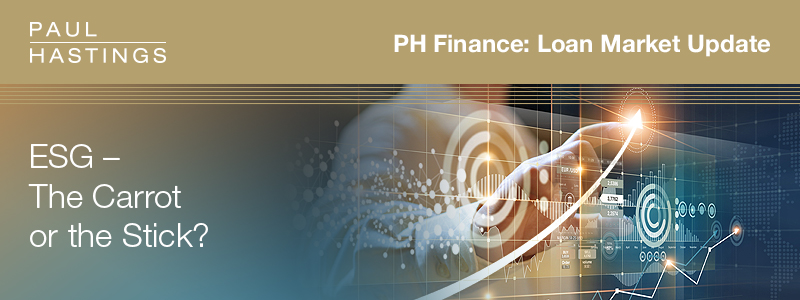Practice Area Articles
ESG - The Carrot or the Stick?
August 02, 2021
The Paul Hastings Finance Practice

Executive Summary
- Environmental, Social & Governance (ESG) loans have closed in record numbers in the first half of 2021.
- Most of the ESG activity in the loan market has been focused on sustainability-linked loans.
- Sustainability-linked loans typically include pricing adjustments (rewards and / or penalties) based on the borrower’s achievement of ESG-related key performance indicators.
- Recently, some credit facilities have featured ESG amendment mechanics to streamline adding in sustainability-linked terms in the future.
- Structuring ESG loans requires careful consideration of the best methods to facilitate ESG improvements and support ESG investment objectives.
- Overview
Whether spurred by post-COVID optimism or increased focus on climate change and social justice initiatives, 2021 appears to be the year of Environmental, Social, and Governance (ESG) activity in the U.S. loan market. ESG loans (primarily sustainability-linked loans, but also a handful of green loans – each described below) have closed in record numbers in the first half of 2021; according to Bloomberg the volume of ESG loans in the U.S. loan market is up 292% percent (as of May 24, 2021) over such volume for all of 2020. ESG loan constructs give market participants the ability to structure deals that include rewards for ESG-related improvements to the borrowers’ business or penalties if the borrower fails to attain certain sustainability linked metrics in loan documentation.
- ESG Loans
ESG loans broadly fall into two categories: (1) green loans and (2) sustainability-linked loans. Green loans generally require that the loan proceeds be used for certain “green” purposes, such as environmental improvements, and are usually tied to the LMA-LSTA-APLMA Green Loan Principles. Sustainability-linked loans, typically based on the LMA-LSTA-APLMA Sustainability Linked Loan Principles & Guidelines (last updated in May of this year), usually include key performance indicators (KPIs) based on environmental, social or other sustainability-linked initiatives, which are then tied to so-called “pricing ratchets” whereby the interest rate margin and / or fees on the loan increase and / or decrease based on the borrower’s performance with respect to these agreed metrics.
- ESG Pricing Incentives
Particularly in the U.S. loan market, sustainability-linked loans will reward borrowers for achievement of the sustainability KPIs (which can range from reductions in greenhouse gas emissions to improvements in diversity and inclusion hiring and retention and everything in between). The KPIs will typically be agreed in advance, subject to reporting on a periodic basis, and are often monitored by a sustainability coordinator or subject to objective criteria created by a third-party entity providing certification on such matters. Upon achieving the KPI targets, there are specified margin or fee decreases based on the extent of sustainability improvements effected by the borrower within the measurement period. In some credit facilities, failure to meet these KPIs has no impact on pricing, which remains fixed (or subject to other pricing criteria) until the KPIs are met and the pricing step-downs are available.
- ESG Pricing Penalties
Recently, U.S. credit facilities have started to build in sustainability-linked pricing penalties, which have been relatively standard to date in European ESG loans. Under such terms, if the borrower fails to meet the agreed KPIs, the margin or fees on the sustainability-linked loan will then increase by specified amounts typically agreed prior to closing. Should the borrower subsequently achieve the KPIs, the now-higher margin or fees will then be ratcheted down, either restoring prior pricing or potentially reducing pricing further if substantial improvements have been made.
- ESG Amendment Mechanics
Another new ESG trend in the U.S. loan market is the ESG amendment mechanic. Instead of building in specific sustainability-linked provisions at closing, credit agreements that include this mechanism detail the amendment process to add sustainability-linked provisions at a future point in time. Typically, such provisions specify whether there will be a fee or margin ratchet, together with the amount thereof, and monitoring requirements (whether by the borrower or by a sustainability coordinator or another third party). The borrower and agent will usually select the sustainability-linked KPIs when the ESG amendment is prepared, subject to a negative consent right for the “Required Lenders” under the credit facility. Adding in an ESG amendment mechanic allows parties to demonstrate their commitment to ESG initiatives, even if they are not yet ready to tackle them at closing, while ostensibly streamlining the related amendment process.
- Key Considerations in ESG Loan Structures
When structuring ESG loans, market participants must decide what the ultimate objective is and the best method to achieve it. Is the ESG pricing ratchet included solely to recognize that the borrower is achieving its projected sustainability-linked goals? Or should the ESG pricing ratchet further incentivize the borrower to try to do better than its plan to either ensure interest and fees do not increase substantially over time or to achieve lower interest and fees? Whatever structure is ultimately chosen, ESG loans present borrowers and lenders with an opportunity to prioritize and recognize environmental and social improvements along with customary business and profit objectives.